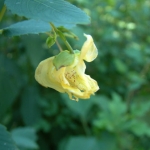| Common Name: |
Pale-touch-me-not |
| Other Names: |
Jewelweed |
| Botanical Name: |
Impatiens pallida |
| Genus: |
Impatiens |
| Family: |
Balsamminaceae |
| Native Location: |
Asia, Africa |
| Cultivation: |
Moist, soil in sun or shade |
| Propagation: |
By seed sown in spring at 16-18°C (61-64°F) |
| Harvest: |
Plants are cut when flowering and used fresh for ointments and juice extraction. |
| Height: |
60cm-1.5m (2-5ft) |
| Width: |
30-60cm (12-24in) |
| Hardiness: |
Hardy |
| Parts Used: |
Whole plant, juice. |
| Properties: |
An acrid herb that has diuretic, purgative and emetic effects if taken internally. |
| Medicinal Uses: |
Externally for rashes caused by Rhus spp. (See, smooth sumac), corns, warts, ringworm (juice), and hemorrhoids (ointment). |
| Bibliography: |
Encylopedia of Herbs by Deni Brown Copyright ©: 1995, 2001 Dorling Kindersley Limited pg 242
|

